Tips:本篇已加入系列文章阅读目录,可点击查看更多相关文章。
前言
在前两节中介绍了ABP模块开发的基本步骤,试着实现了一个简单的文件管理模块;功能很简单,就是基于本地文件系统来完成文件的读写操作,数据也并没有保存到数据库,所以之前只简单使用了应用服务,并没有用到领域层。而在DDD中领域层是非常重要的一层,其中包含了实体,聚合根,领域服务,仓储等等,复杂的业务逻辑也应该在领域层来实现。本篇来完善一下文件管理模块,将文件记录保存到数据库,并使用ABP BLOB系统来完成文件的存储。
开始
聚合根
首先从实体模型开始,建立File实体。按照DDD的思路,这里的File应该是一个聚合根。
modulesfile-managementsrcXhznl.FileManagement.DomainFilesFile.cs:
public class File : FullAuditedAggregateRoot<Guid>, IMultiTenant
{
public virtual Guid? TenantId { get; protected set; }
[NotNull]
public virtual string FileName { get; protected set; }
[NotNull]
public virtual string BlobName { get; protected set; }
public virtual long ByteSize { get; protected set; }
protected File() { }
public File(Guid id, Guid? tenantId, [NotNull] string fileName, [NotNull] string blobName, long byteSize) : base(id)
{
TenantId = tenantId;
FileName = Check.NotNullOrWhiteSpace(fileName, nameof(fileName));
BlobName = Check.NotNullOrWhiteSpace(blobName, nameof(blobName));
ByteSize = byteSize;
}
}
在DbContext中添加DbSet
modulesfile-managementsrcXhznl.FileManagement.EntityFrameworkCoreEntityFrameworkCoreIFileManagementDbContext.cs:
public interface IFileManagementDbContext : IEfCoreDbContext
{
DbSet<File> Files { get; }
}
modulesfile-managementsrcXhznl.FileManagement.EntityFrameworkCoreEntityFrameworkCoreFileManagementDbContext.cs:
public class FileManagementDbContext : AbpDbContext<FileManagementDbContext>, IFileManagementDbContext
{
public DbSet<File> Files { get; set; }
......
}
配置实体
modulesfile-managementsrcXhznl.FileManagement.EntityFrameworkCoreEntityFrameworkCoreFileManagementDbContextModelCreatingExtensions.cs:
public static void ConfigureFileManagement(
this ModelBuilder builder,
Action<FileManagementModelBuilderConfigurationOptions> optionsAction = null)
{
......
builder.Entity<File>(b =>
{
//Configure table & schema name
b.ToTable(options.TablePrefix + "Files", options.Schema);
b.ConfigureByConvention();
//Properties
b.Property(q => q.FileName).IsRequired().HasMaxLength(FileConsts.MaxFileNameLength);
b.Property(q => q.BlobName).IsRequired().HasMaxLength(FileConsts.MaxBlobNameLength);
b.Property(q => q.ByteSize).IsRequired();
});
}
仓储
ABP为每个聚合根或实体提供了 默认的通用(泛型)仓储 ,其中包含了标准的CRUD操作,注入IRepository<TEntity, TKey>即可使用。通常来说默认仓储就够用了,有特殊需求时也可以自定义仓储。
定义仓储接口
modulesfile-managementsrcXhznl.FileManagement.DomainFilesIFileRepository.cs:
public interface IFileRepository : IRepository<File, Guid>
{
Task<File> FindByBlobNameAsync(string blobName);
}
仓储实现
modulesfile-managementsrcXhznl.FileManagement.EntityFrameworkCoreFilesEfCoreFileRepository.cs:
public class EfCoreFileRepository : EfCoreRepository<IFileManagementDbContext, File, Guid>, IFileRepository
{
public EfCoreFileRepository(IDbContextProvider<IFileManagementDbContext> dbContextProvider) : base(dbContextProvider)
{
}
public async Task<File> FindByBlobNameAsync(string blobName)
{
Check.NotNullOrWhiteSpace(blobName, nameof(blobName));
return await DbSet.FirstOrDefaultAsync(p => p.BlobName == blobName);
}
}
注册仓储
modulesfile-managementsrcXhznl.FileManagement.EntityFrameworkCoreEntityFrameworkCoreFileManagementEntityFrameworkCoreModule.cs:
public class FileManagementEntityFrameworkCoreModule : AbpModule
{
public override void ConfigureServices(ServiceConfigurationContext context)
{
context.Services.AddAbpDbContext<FileManagementDbContext>(options =>
{
options.AddRepository<File, EfCoreFileRepository>();
});
}
}
领域服务
定义领域服务接口
modulesfile-managementsrcXhznl.FileManagement.DomainFilesIFileManager.cs:
public interface IFileManager : IDomainService
{
Task<File> FindByBlobNameAsync(string blobName);
Task<File> CreateAsync(string fileName, byte[] bytes);
Task<byte[]> GetBlobAsync(string blobName);
}
在实现领域服务之前,先来安装一下ABP Blob系统核心包,因为我要使用blob来存储文件,Volo.Abp.BlobStoring包是必不可少的。
BLOB存储
BLOB(binary large object):大型二进制对象;关于BLOB可以参考 BLOB 存储 ,这里不多介绍。
安装Volo.Abp.BlobStoring,在Domain项目目录下执行:abp add-package Volo.Abp.BlobStoring
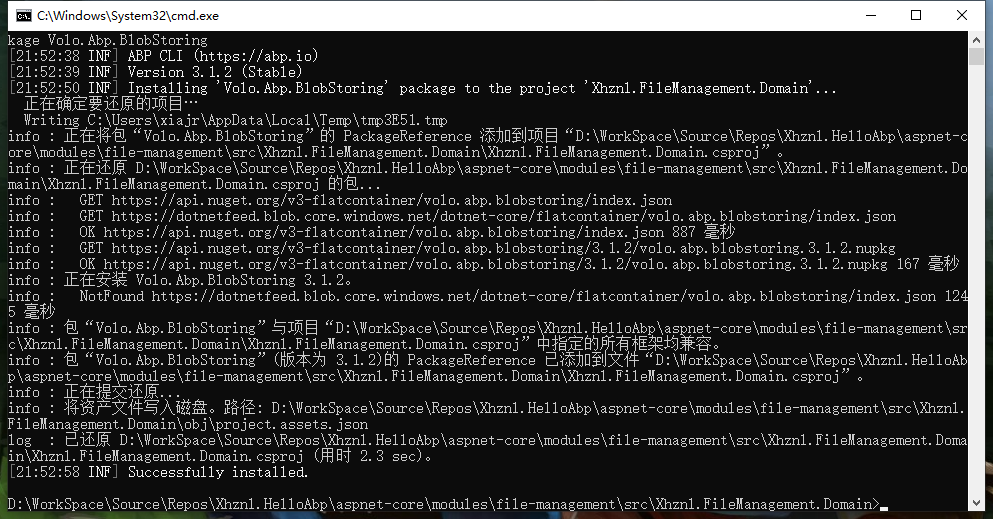
Volo.Abp.BlobStoring是BLOB的核心包,它仅包含BLOB的一些基本抽象,想要BLOB系统正常工作,还需要为它配置一个提供程序;这个提供程序暂时不管,将来由模块的具体使用者去提供。这样的好处是模块不依赖特定存储提供程序,使用者可以随意的指定存储到阿里云,Azure,或者文件系统等等。。。
领域服务实现
modulesfile-managementsrcXhznl.FileManagement.DomainFilesFileManager.cs:
public class FileManager : DomainService, IFileManager
{
protected IFileRepository FileRepository { get; }
protected IBlobContainer BlobContainer { get; }
public FileManager(IFileRepository fileRepository, IBlobContainer blobContainer)
{
FileRepository = fileRepository;
BlobContainer = blobContainer;
}
public virtual async Task<File> FindByBlobNameAsync(string blobName)
{
Check.NotNullOrWhiteSpace(blobName, nameof(blobName));
return await FileRepository.FindByBlobNameAsync(blobName);
}
public virtual async Task<File> CreateAsync(string fileName, byte[] bytes)
{
Check.NotNullOrWhiteSpace(fileName, nameof(fileName));
var blobName = Guid.NewGuid().ToString("N");
var file = await FileRepository.InsertAsync(new File(GuidGenerator.Create(), CurrentTenant.Id, fileName, blobName, bytes.Length));
await BlobContainer.SaveAsync(blobName, bytes);
return file;
}
public virtual async Task<byte[]> GetBlobAsync(string blobName)
{
Check.NotNullOrWhiteSpace(blobName, nameof(blobName));
return await BlobContainer.GetAllBytesAsync(blobName);
}
}
应用服务
接下来修改一下应用服务,应用服务通常没有太多业务逻辑,其调用领域服务来完成业务。
应用服务接口
modulesfile-managementsrcXhznl.FileManagement.Application.ContractsFilesIFileAppService.cs:
public interface IFileAppService : IApplicationService
{
Task<FileDto> FindByBlobNameAsync(string blobName);
Task<string> CreateAsync(FileDto input);
}
应用服务实现
modulesfile-managementsrcXhznl.FileManagement.ApplicationFilesFileAppService.cs:
public class FileAppService : FileManagementAppService, IFileAppService
{
protected IFileManager FileManager { get; }
public FileAppService(IFileManager fileManager)
{
FileManager = fileManager;
}
public virtual async Task<FileDto> FindByBlobNameAsync(string blobName)
{
Check.NotNullOrWhiteSpace(blobName, nameof(blobName));
var file = await FileManager.FindByBlobNameAsync(blobName);
var bytes = await FileManager.GetBlobAsync(blobName);
return new FileDto
{
Bytes = bytes,
FileName = file.FileName
};
}
[Authorize]
public virtual async Task<string> CreateAsync(FileDto input)
{
await CheckFile(input);
var file = await FileManager.CreateAsync(input.FileName, input.Bytes);
return file.BlobName;
}
protected virtual async Task CheckFile(FileDto input)
{
if (input.Bytes.IsNullOrEmpty())
{
throw new AbpValidationException("Bytes can not be null or empty!",
new List<ValidationResult>
{
new ValidationResult("Bytes can not be null or empty!", new[] {"Bytes"})
});
}
var allowedMaxFileSize = await SettingProvider.GetAsync<int>(FileManagementSettings.AllowedMaxFileSize);//kb
var allowedUploadFormats = (await SettingProvider.GetOrNullAsync(FileManagementSettings.AllowedUploadFormats))
?.Split(",", StringSplitOptions.RemoveEmptyEntries);
if (input.Bytes.Length > allowedMaxFileSize * 1024)
{
throw new UserFriendlyException(L["FileManagement.ExceedsTheMaximumSize", allowedMaxFileSize]);
}
if (allowedUploadFormats == null || !allowedUploadFormats.Contains(Path.GetExtension(input.FileName)))
{
throw new UserFriendlyException(L["FileManagement.NotValidFormat"]);
}
}
}
API控制器
最后记得将服务接口暴露出去,我这里是自己编写Controller,你也可以使用ABP的自动API控制器来完成,请参考 自动API控制器
modulesfile-managementsrcXhznl.FileManagement.HttpApiFilesFileController.cs:
[RemoteService]
[Route("api/file-management/files")]
public class FileController : FileManagementController
{
protected IFileAppService FileAppService { get; }
public FileController(IFileAppService fileAppService)
{
FileAppService = fileAppService;
}
[HttpGet]
[Route("{blobName}")]
public virtual async Task<FileResult> GetAsync(string blobName)
{
var fileDto = await FileAppService.FindByBlobNameAsync(blobName);
return File(fileDto.Bytes, MimeTypes.GetByExtension(Path.GetExtension(fileDto.FileName)));
}
[HttpPost]
[Route("upload")]
[Authorize]
public virtual async Task<JsonResult> CreateAsync(IFormFile file)
{
if (file == null)
{
throw new UserFriendlyException("No file found!");
}
var bytes = await file.GetAllBytesAsync();
var result = await FileAppService.CreateAsync(new FileDto()
{
Bytes = bytes,
FileName = file.FileName
});
return Json(result);
}
}
单元测试
针对以上内容做一个简单的测试,首先为Blob系统配置一个提供程序。
我这里使用最简单的文件系统来储存,所以需要安装Volo.Abp.BlobStoring.FileSystem。在Application.Tests项目目录下执行:abp add-package Volo.Abp.BlobStoring.FileSystem
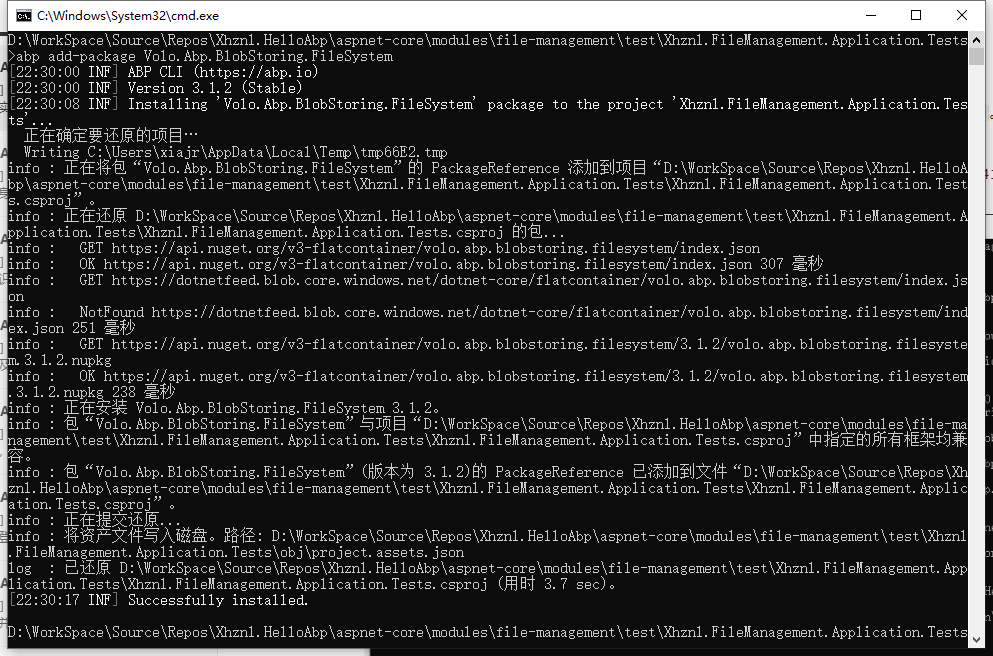
配置默认容器
modulesfile-management estXhznl.FileManagement.Application.TestsFileManagementApplicationTestModule.cs:
[DependsOn(
typeof(FileManagementApplicationModule),
typeof(FileManagementDomainTestModule),
typeof(AbpBlobStoringFileSystemModule)
)]
public class FileManagementApplicationTestModule : AbpModule
{
public override void ConfigureServices(ServiceConfigurationContext context)
{
Configure<AbpBlobStoringOptions>(options =>
{
options.Containers.ConfigureDefault(container =>
{
container.UseFileSystem(fileSystem =>
{
fileSystem.BasePath = "D:\my-files";
});
});
});
base.ConfigureServices(context);
}
}
测试用例
modulesfile-management estXhznl.FileManagement.Application.TestsFilesFileAppService_Tests.cs:
public class FileAppService_Tests : FileManagementApplicationTestBase
{
private readonly IFileAppService _fileAppService;
public FileAppService_Tests()
{
_fileAppService = GetRequiredService<IFileAppService>();
}
[Fact]
public async Task Create_FindByBlobName_Test()
{
var blobName = await _fileAppService.CreateAsync(new FileDto()
{
FileName = "微信图片_20200813165555.jpg",
Bytes = await System.IO.File.ReadAllBytesAsync(@"D:WorkSpaceWorkFiles杂项图片微信图片_20200813165555.jpg")
});
blobName.ShouldNotBeEmpty();
var fileDto = await _fileAppService.FindByBlobNameAsync(blobName);
fileDto.ShouldNotBeNull();
fileDto.FileName.ShouldBe("微信图片_20200813165555.jpg");
}
}
运行测试

测试通过,blob也已经存入D:my-files:
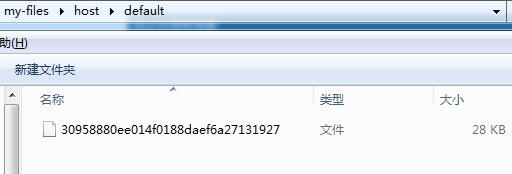
模块引用
下面回到主项目,前面的章节中已经介绍过,模块的引用依赖都已经添加完成,下面就直接从数据库迁移开始。
srcXhznl.HelloAbp.EntityFrameworkCore.DbMigrationsEntityFrameworkCoreHelloAbpMigrationsDbContext.cs:
public class HelloAbpMigrationsDbContext : AbpDbContext<HelloAbpMigrationsDbContext>
{
public HelloAbpMigrationsDbContext(DbContextOptions<HelloAbpMigrationsDbContext> options)
: base(options)
{
}
protected override void OnModelCreating(ModelBuilder builder)
{
......
builder.ConfigureFileManagement();
......
}
}
打开程序包管理器控制台,执行以下命令:
Add-Migration "Added_FileManagement"
Update-Database
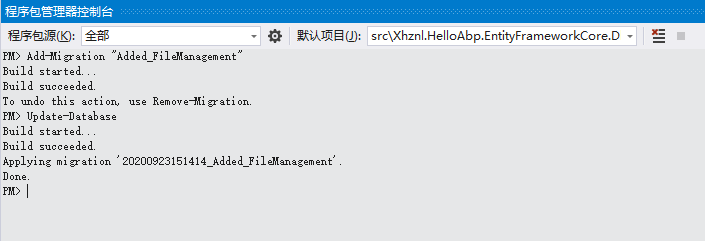
此时数据库已经生成了File表:
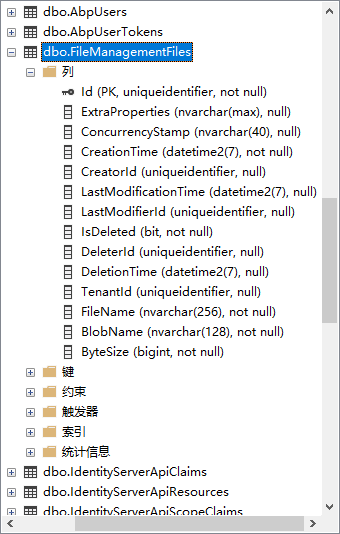
还有记得在HttpApi.Host项目配置你想要的blob提供程序。
最后结合前端测试一下吧:
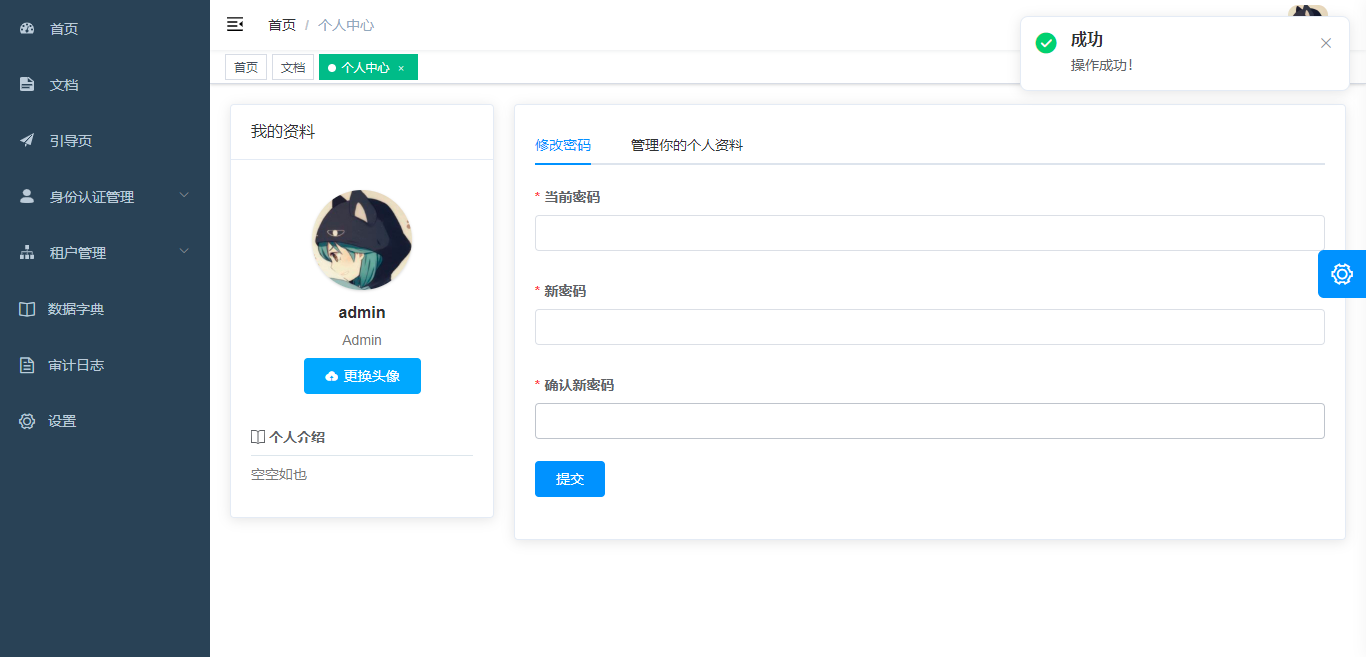

最后
以上就是本人所理解的abp模块开发一个相对完整的流程,还有些概念后面再做补充。因为这个例子比较简单,文中有些环节是不必要的,需要结合实际情况去取舍。代码地址:https://github.com/xiajingren/HelloAbp